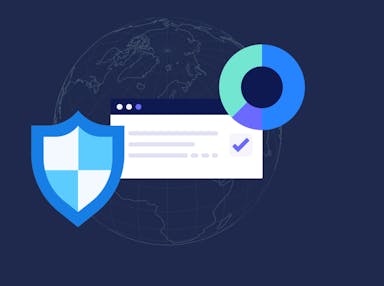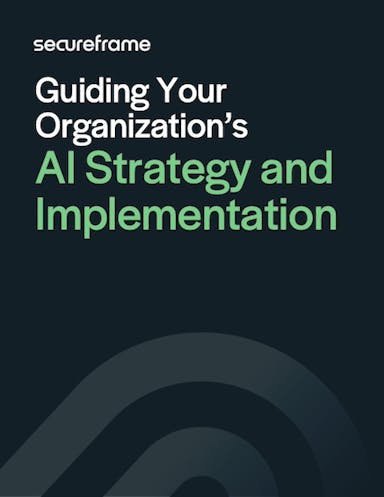
Artificial Intelligence in 2025: The New Foundation for Security Compliance
Emily Bonnie
Senior Content Marketing Manager
Anna Fitzgerald
Senior Content Marketing Manager
The rapid advancement of artificial intelligence (AI) has shifted from experimentation to transformation. AI is no longer enhancing isolated workflows; it's becoming deeply embedded across every layer of enterprise operations, including one of the most critical and complex areas: security compliance.
As SaaS businesses, cloud-native organizations, and highly regulated industries wrestle with growing data security and regulatory compliance demands, AI is fundamentally reshaping how companies approach security and compliance operations.
Let’s take a closer look at how AI continues to evolve and how organizations are using it to strengthen security postures, stay ahead of threats, and simplify the increasingly complex compliance landscape.
What is AI? Why 2025 is a turning point
To say artificial intelligence is having a moment would be an understatement. But what exactly is meant by AI — Siri? ChatGPT? Skynet? How does AI work and what are the different types?
Artificial intelligence refers to machines performing tasks that have traditionally required human intelligence, such as analyzing data, making decisions, understanding language, or learning from experience. That core definition remains unchanged, but in 2025, AI’s accessibility, sophistication, and business impact have grown at a pace few anticipated.
The most significant breakthrough in recent years has been the rise of generative AI (GenAI). Systems like GPT-4o, Claude, and Gemini create text, code, and analysis based on massive training data. These tools have expanded AI’s role from simple automation to reasoning, synthesis, and contextual decision-making.
AI is still often described in terms of Narrow AI (task-specific systems like speech recognition or anomaly detection) and General AI (hypothetical human-like reasoning that can apply across domains). However, much of today’s enterprise AI operates in between these two extremes. Modern foundation models combine natural language processing, machine learning, reasoning, and real-time data analysis to support increasingly complex business functions.
- Machine Learning (ML): ML systems can learn and improve from experience. These systems identify patterns in data and make predictions or decisions without being explicitly programmed to do so. ML includes subsets such as deep learning and neural networks.
- Natural Language Processing (NLP): This technology allows AI systems to read, decipher, understand, and make sense of human language in a valuable way.
- Expert Systems: These are AI programs that use a knowledge base of human expertise for problem-solving. They are designed to provide expert-quality decisions in specific domains like healthcare, finance, and engineering.
- Robotics: This branch of AI focuses on creating machines that can move and react to sensory input, such as computer vision. Robots can perform tasks in place of humans, especially in dangerous environments or manufacturing processes.
- Speech Recognition: AI systems with this capability can understand spoken language and convert it into text or commands, as with voice search.
For security and compliance teams, these advances unlock new possibilities for automation, speed, and accuracy.
The state of enterprise AI adoption in 2025
Adoption of AI has accelerated sharply. According to a 2024 McKinsey survey, 72% of businesses report actively integrating AI into at least one business function, up from 50% in 2022. What was once limited to research labs and innovation teams has quickly become embedded in core operations across industries.
Security and compliance functions are among the fastest-growing AI use cases. As organizations face mounting regulatory complexity, growing attack surfaces, and pressure to do more with limited resources, AI is increasingly seen not just as a helpful tool but as a critical enabler for managing risk, improving audit readiness, and maintaining continuous compliance.
At the same time, this rapid adoption is introducing new layers of complexity. Many organizations are now deploying AI models that influence decision-making, process sensitive data, or even generate audit evidence. As a result, regulators are paying closer attention to how AI systems themselves are governed, monitored, and controlled.
Gartner projects that by 2026, 60% of organizations will have formalized AI governance programs to manage risks such as model drift, data privacy violations, ethical concerns, and regulatory non-compliance. For many security and compliance leaders, this means managing both compliance through AI and compliance of AI itself.
The convergence of AI adoption and AI governance is creating a new chapter for risk and compliance management. Companies are not only leveraging AI to simplify compliance workflows but also adopting new frameworks like ISO 42001 and the NIST AI RMF to ensure their AI usage aligns with evolving standards, regulations, and ethical expectations.
How SaaS companies are using AI for security compliance
Now that we’ve established the current state of AI capabilities, let's shift our focus to how AI can help organizations achieve and maintain compliance with security frameworks and industry standards.
Continuous control and compliance monitoring
Periodic control testing is no longer sufficient for modern environments. AI enables continuous control monitoring that ingests data from cloud platforms, identity providers, ticketing systems, and data repositories. Models analyze this data in real time, detect control drift, and surface potential compliance gaps before they escalate into audit failures.
Many regulatory and security frameworks also require continuous monitoring, including SOC 2, ISO 27001, CMMC 2.0, and FedRAMP 20x. AI provides real-time visibility that saves time, reduces human error, and increases the overall efficiency of compliance efforts.
Recommended Reading

6 Benefits of Continuous Monitoring for Cybersecurity
GenAI-driven policy creation and updates
Drafting and maintaining compliance policies is one of the most time-consuming aspects of audit preparation. AI can now generate initial policy drafts based on selected frameworks, then fine-tune language based on regulatory updates, organizational tone, and auditor expectations. This reduces manual drafting time while improving alignment with current standards.
Automated evidence collection and control mapping
AI models can ingest logs, asset inventories, access data, and ticket workflows, and then map them to applicable controls across multiple frameworks. This helps maintain continuously updated audit-ready evidence libraries and reduces the resource drain that traditionally accompanies annual audits.
Cross-framework control mapping
AI is increasingly serving as the engine behind cross-mapping controls across multiple frameworks. Organizations with overlapping obligations under SOC 2, ISO 27001, GDPR, HIPAA, FedRAMP, and CMMC can use AI to maintain unified, continuously updated compliance states without duplicating efforts.
Intelligent risk assessment
AI can analyze control performance, vulnerability data, vendor risk profiles, and regulatory updates to generate real-time risk scores. These AI-powered risk assessments help organizations maintain current visibility into emerging risks while remaining aligned with risk assessment standards like ISO 27005 and NIST 800-30.
Accelerated remediation
When issues are detected, AI models can recommend remediation steps based on the specific control framework, risk category, and system configuration involved. Solutions like Secureframe’s Comply AI for Remediation can suggest configuration changes, access adjustments, or compensating controls, allowing teams to address compliance gaps more quickly.
Personalized security awareness training
AI-driven training platforms create individualized security awareness programs tailored to an employee's role, behavior patterns, and learning history. Personalized content improves engagement and knowledge retention, which helps reduce human error, one of the leading causes of security incidents.
Third-party risk automation
AI is increasingly automating vendor risk assessments by parsing security questionnaires, audit reports, certifications, and public disclosures. These models can extract key information, flag gaps, assign risk scores, and dramatically accelerate vendor onboarding processes while improving accuracy.
AI-powered audit readiness
AI-powered platforms maintain a live snapshot of organizational compliance status, automatically generate pre-mapped audit packages, and simulate audit readiness reviews. This ongoing visibility eliminates much of the scrambling and manual preparation that has historically characterized audit season.
Recommended reading

Secureframe Continues to Lead AI Innovation in Compliance, Helping Customers Work More Efficiently
Where AI is headed next: The 2025-2026 horizon
AI's ability to analyze vast quantities of datasets, identify patterns, and make decisions is opening doors to new possibilities in security and compliance. While AI has already made a significant impact on how security and compliance teams operate, this role continues to expand as emerging AI trends take shape. Let's explore some exciting developments and use cases on the horizon.
AI-augmented auditors
Auditors are increasingly using AI-powered assistants to ingest evidence, map controls, validate tests, and surface exceptions. Deloitte estimates these tools could reduce manual audit hours by 30% to 50% while increasing the consistency and quality of control testing.
Predictive compliance drift detection
AI models are beginning to forecast likely control failures before they happen by analyzing historical performance data, configuration changes, and evolving risk patterns. This allows security teams to address emerging issues proactively.
Regulatory AI governance
Governments are beginning to regulate AI itself. The EU AI Act, various U.S. Executive Orders, and the NIST AI Risk Management Framework are setting new standards for how companies build, deploy, and monitor AI models. Many organizations are now using AI-powered governance tools to monitor for model drift, bias, and compliance violations.

Guiding Your Organization's AI Strategy and Implementation
As the use of AI in cybersecurity continues to grow, cybersecurity leaders will play a critical role in harnessing the potential of AI while ensuring its secure and effective implementation. By following these best practices, leaders can effectively implement AI while addressing concerns related to transparency, privacy, and security.
AI is now foundational to modern GRC programs
The scale, speed, and complexity of compliance requirements have made manual compliance increasingly unsustainable. AI is augmenting security and compliance professionals, allowing teams to focus on strategic governance and oversight while automation handles the complexity of day-to-day operations.
Recent Moody’s research found that 68% of organizations believe AI will have a transformational impact on compliance management within the next three years. Companies that invest early in AI-powered compliance automation are already seeing faster time to audit readiness, reduced operational burden, and greater confidence in their security posture.
At Secureframe, AI is thoughtfully embedded into our platform across the entire compliance lifecycle to help organizations move faster, reduce risk, and stay audit-ready.
- Comply AI for Remediation accelerates the process of fixing failing controls in cloud environments. By generating infrastructure-as-code fixes for AWS, Azure, and GCP, it allows teams to quickly copy, paste, and deploy remediations, improving both security posture and operational efficiency.
- Comply AI for Risk simplifies risk assessments by analyzing risk descriptions and automatically generating inherent risk scores, treatment plans, and residual risk ratings. This helps security teams assess and respond to risks faster, more consistently, and with greater confidence.
- Comply AI for Policies transforms policy development with generative AI-powered drafting and editing. Teams can quickly generate policy drafts, fine-tune language, and align content with internal standards and regulatory frameworks, all in minutes rather than days.
- ML-powered Questionnaire Automation dramatically reduces the time spent on RFPs and security questionnaires. Trust AI leverages machine learning to analyze documentation, extract relevant answers, and auto-generate accurate responses, helping organizations respond to due diligence requests faster and more consistently.
- AI Evidence Validation uses advanced AI to review uploaded evidence and provide real-time feedback on key audit criteria. It automatically verifies whether evidence files match control requirements, checks timestamp accuracy, and flags potential gaps before an auditor reviews the materials, leading to smoother audits and better assessment outcomes.
- AI Framework Support helps organizations align with emerging AI risk management standards like NIST AI RMF and ISO 42001, enabling responsible AI governance and compliance as global regulatory frameworks evolve.
- Secureframe MCP Server extends AI’s value by allowing AI assistants and developer tools that support the Model Context Protocol (MCP) to query Secureframe compliance data directly, making compliance insights accessible in real time through conversational interfaces.
Secureframe’s AI-powered platform delivers not just automation but true intelligence across every phase of the compliance journey. The organizations that embrace these capabilities today are building compliance operations that are faster, more resilient, and future-proof.
See how Secureframe AI can simplify your compliance program in 2025. Schedule a personalized demo with our team today.
Use trust to accelerate growth

Emily Bonnie
Senior Content Marketing Manager
Emily Bonnie is a seasoned digital marketing strategist with over ten years of experience creating content that attracts, engages, and converts for leading SaaS companies. At Secureframe, she helps demystify complex governance, risk, and compliance (GRC) topics, turning technical frameworks and regulations into accessible, actionable guidance. Her work aims to empower organizations of all sizes to strengthen their security posture, streamline compliance, and build lasting trust with customers.

Anna Fitzgerald
Senior Content Marketing Manager
Anna Fitzgerald is a digital and product marketing professional with nearly a decade of experience delivering high-quality content across highly regulated and technical industries, including healthcare, web development, and cybersecurity compliance. At Secureframe, she specializes in translating complex regulatory frameworks—such as CMMC, FedRAMP, NIST, and SOC 2—into practical resources that help organizations of all sizes and maturity levels meet evolving compliance requirements and improve their overall risk management strategy.